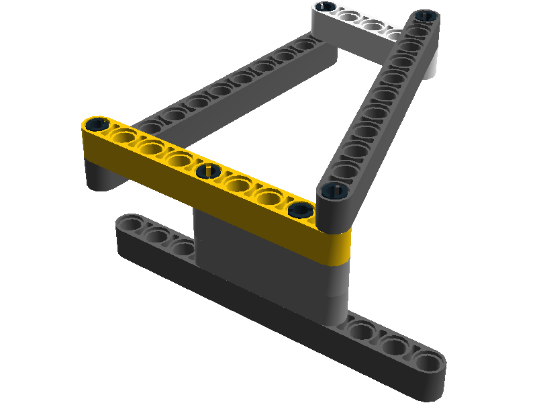Verification of correctness
In this section we illustrate how the verification of the correctness of a linkage construction can be performed by using GeoGebra ART. Actually, we will obtain a proof in each case.
Chebyshev's linkage
Chebyshev was of the firm belief for many years that linkages could never be designed to produce exact straight lines. This is one reason why Chebyshev's effort in constructing an almost straight line motion by using a 4 bar linkage should be remarked.
The Chebyshev linkage draws two parts of a sextic curve, namely The appearing polynomial is again irreducible over the reals. The "upper" part of the curve can be drawn with the bars having a "normal" layout, but the straight-looking part requires the radius arms to be crossed.
Chebyshev's linkage in GeoGebra
We can extend the investigation steps discussed at Watt's linkage as follows:
- Construct a GeoGebra model of the linkage. Check the validity of the impression numerically for some selected configurations of the moving point. (Change the Algebra Descriptions to Value to achieve this.) Here we may choose a range of seemingly well behaving situation to confirm the impression. If rounding is set to 2 decimal places, dragging B on the circle c between points (5.08,0.61) and (6.71,-0.59) the y-coordinate of point P will be equal to 0.
- Add seemingly fix objects to the construction for further investigation of the proper relations. In this step the expected horizontal line p will be created explicitly by rotating A around D by 90 degrees clockwise. (Points A and D are intentionally on the line y=-8. This ensures that o seems to contain a longer segment on the x-axis.)
- Check the validity of the impression numerically for some selected points. By using the Pythagorean theorem it is easy to see that there are arguments that the lower part of the curve may be a straight line, for example B=(8,2) or (0,2) or (6,0) all confirm the false impression. So here we choose a "well behaving" situation to confirm the wrong conjecture. The used GeoGebra way is again the Relation tool when obtaining information if the tracer point P lies on p, by dragging B to (6,0).
- Check the validity of the impression by continuing the investigation by using the More... button of the Relation Tool. This will refute the false impression.
A Lego Technic model
The Chebyshev linkage can also be introduced in the classroom by using LEGO Technic bricks. A possible assembly includes 17 parts, and then a pen refill can draw the linkage on a sheet of paper.

How to draw the Chebyshev curve with the Lego model
Russell's linkage
After two unsuccessful attempts we provide a simple example to create an exactly straight line. A little facilitation for the next attempt is that one of the bars will slide on a straight constraint. In other words, a pivot of the construction is guided in a straight line, that is we construct a guide linkage.
More precisely, this model will provide us a rotation of an existing straight line. The construction is known as Russell's linkage and can be quickly drawn.
Since having a really straight line, our steps will slightly differ from the previously discussed ones:
- Construct a GeoGebra model of the linkage.
- Check the validity of the impression numerically for any selected points. Here we may choose the full range of moving points to confirm the impression.
- Add some seemingly fix objects to the construction for further investigation of the proper relations. In this step the expected horizontal line i will be created explicitly by rotating A around B by 90 degrees counterclockwise and getting A', finally line i:=A'B.
- Check the validity of the impression numerically for any selected configuration of the moving point. Here we may choose an arbitrary position to confirm the impression. The used GeoGebra tool is again the Relation tool when obtaining information if the tracer point C' lies on i.
- Check the validity of the impression by continuing the investigation by using the More... button of the Relation Tool. This will confirm the impression: GeoGebra will report that the relation always holds but "under certain conditions". This can be interpreted that there are some degenerate cases in which the property does not hold, but GeoGebra cannot describe this degeneracy (because it has no simple geometrical meaning).
- Alternatively, the command LocusEquation[C',C] can compute the set of tracer points and visualize them as a union of a horizontal line and a circle. This will point out that the degeneracy will occur in the situation when C=B, and in this case the set of possible points of C' is a whole circle with center B and circumpoint A.